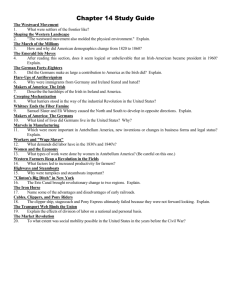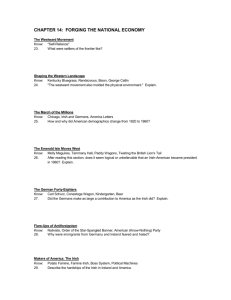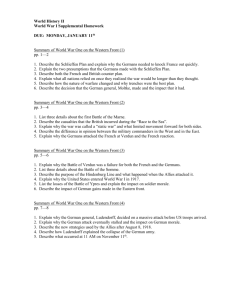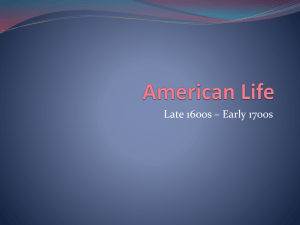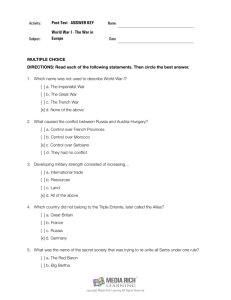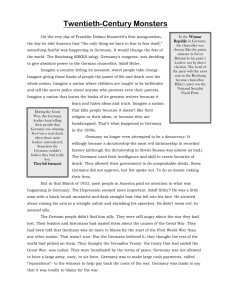Understanding Global Cultures
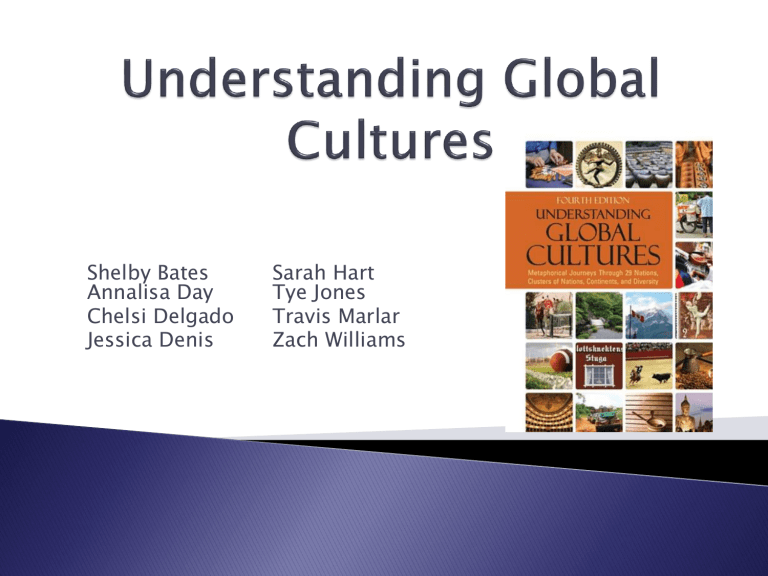
Shelby Bates
Annalisa Day
Sarah Hart
Tye Jones
Chelsi Delgado Travis Marlar
Jessica Denis Zach Williams
Chapter 11
◦ The Danish Christmas Luncheon
Chapter 12
◦ The German Symphony
Chapter 13
◦ Irish Conversations
◦ 5.4 population
◦ Highly educated
◦ GDP per person $44,710
Ranks 7 th among nations
◦ Composed of 406 islands
◦ Equality matching culture
All organizations in Denmark host a luncheon
◦ Employee and employer responsibility
Occurs on one of three Fridays in December
Begins at 1pm
Controlled culture
◦ Inappropriate thoughts, emotions, and actions
Queen Margrethe of Denmark united
Denmark, Norway, and Sweden in 1397
◦ Norway belonged to Denmark until 1814
◦ Gradually diminished because of periodic wars
WWII
◦ Germany invaded Norway and Denmark
◦ Armbands
◦ Dangerously led Jewish Danes to neutral Sweden
Saved 95% of 7,000 Jewish residents
Individualistic
◦ Ranked 9 th of 53
Interdependent
◦ Geography, small size, and history
Both individuality and group norms are both respected
◦ Wealthy residence
Tendency toward conformity
◦ Christmas luncheon provides an escape from that
◦ Allowed to express forbidden thoughts and emotions
Easily could have ended up a part of Germany after Germany became a nation in 1870
◦ Faced this threat again in WWII
Military virtually non-existent
◦ Large medical corps set up for national emergency
Relaxed approach to life; more than neighbors
◦ Study of international happiness involving 80,000 respondents, Denmark won first-place
◦ Very modest expectations
◦ Relaxed sexual relations: nude bathing, escorts
Shortage of labor
◦ Young Danes take advantage of the great education, then move to other countries with lower taxes
63%: free health care, child care, and elder care
Low-skilled immigrants
Elaborate
◦ Home-cooked dishes, candles, fireplace
Most employees work for the same organization all their lives
◦ Enhance a sense of coziness and commonality
Luncheon started in homes and communities, but is now a norm for Danish businesses
It is difficult to understand Germans at times from an American point of view
Even though 30% of Americans are from
German descent
German stereotype: Emphasis on rules and order
Germany is relatively young compared to its
European neighbors
◦ Becomes a nation in 1871
Ancestors of the Germans led by Hermann the Great defeated the Romans in 109BCE
The word “German” was a derogatory term
German mercenaries that fought in the
American revolution were ridiculed
Fredrick the Great and his Father
◦ Produced a strong Prussia
◦ Fredrick the Great was interested in music and philosophy
◦ He also wrote flute music
◦ All these characteristics would foreshadow the
Germany to come
Through leadership in government and military smaller kingdoms integrated into what we now know as Germany
These kingdoms kept their individuality because of diverse historic backgrounds
◦ Because of this Germany operates a federal confederation of 16 independent states
Germans romanticize Charlemagne’s Roman rule as the first Reich
◦ Reich: German word which designates “realm” or
“commonwealth” translated to English means “rich”
◦ This lavish tale was due to the lack of illustrious history of their own
◦
◦ Germany bordered Eastern and Western Europe this resulted in a great diversity of ethnic groups
Began in 1871
◦ Militarism and rapid economic growth
◦ Education, culture, and the arts (especially the symphony)
Otto Von Bismarck
◦ Iron Chancellor
◦ First social welfare system
Required age of 65 to receive government pension
World War I
◦ Versailles Peace Treaty of 1918
Germany had to pay reparations to certain countries it caused damage to in the war
Damages were valued at 132 million Marks
$442 billion in 2012’s money
Economists, especially Maynard Keynes, saw this as excessive and knew it would doom Germany’s economy
The Depression of 1930 only worsened
Germany’s economic situation
◦ Political turmoil occurred, groups vied for power
◦ National Socialist Party came to power
◦ Chancellor Hindenburg asks their leader to create minority government
◦ Hitler creates minority government and Germans see him as a source of stability
◦ Hitler ushers in the Third Reich (1000 year)
Modern Germany began after the Allies took control in 1945
◦ Democratic government
◦ Labor unions
Marshall Plan
◦ Aided war ravaged Europe rebuild their economies
◦ First time in history this occurred
Germany’s economy strengthens
◦ More exports per capita than U.S. and Japan
◦ Extensive regulations have pushed German companies into other nations (small and medium size firms)
◦ Germany scored 15 on individualism
This is very high much like America
Germans Love symphonic music
Germans believe the symphony is symbolic of their culture
◦ Individuals likes and dislikes are subordinated for the greater good
West Germany has a population of 66 million and has more than 80 orchestras
Some of the world’s greatest composers are
German
◦ Haydn, Mozart, Schubert, Bach, Beethoven
Many Germans play musical instruments as a hobby
Music is an integral and a serious part of life
Collective experience that enriches life
Characteristic feature of the Germans = multiplicity -
Prince Metternich
Many different ethnic and religious groups
Most diverse city: Frankfurt
Different ethnicities
◦ Germany rarely united, marked by division
◦ East and West Germany united on October 3, 1990
Both people of Germany and musical instruments of the symphonic orchestra come from many different countries and cultures
Primary force
Many foreigners moved into Germany:
◦ After the first unification in 1871
◦ After the construction of the Berlin Wall
◦ With the end of the Cold War in Europe
Immigrant Percentages:
◦ Germany: 8%
◦ United States: 12%
◦ South Africa: 2.3%
The area of the former East Germany now accounts for around 30% of Germany
Around the size of Montana
Integration of East and West Germany has been challenging
◦ High costs
◦ High unemployment
South
◦ Sunny, warmer climate
◦ Mostly Protestant
North
◦ Colder climate
◦ Mostly Catholic
Creation of complexity
◦ Incorporating more diversity into the new nation
◦ Adding musical instruments in the symphonic orchestra
4 sections:
◦ Strings
◦ Woodwinds
◦ Brass
◦ Percussion
Maximize the musical instrumentation
Improve the quality of the sound
Very crowded
◦ Germany: 230.5 residents/sq. km.
◦ United States: 31.7 residents/sq. km.
◦ South Africa: 41 residents/sq. km.
Compartmentalized
◦ Affection for privacy and respect for others
The home separates one from the outside world
Germany
◦
◦ The privacy and security of the home is valued especially during this time
Gemutlichkeit strongly prevails
Translation: “as ‘comfort’ or ‘coziness,’ but it has wider connotations – of the hearthside and deep content, of home cooking and family security”
South Africa
◦ An “out-of-door” day
◦ Most time spent on the beaches, rivers, and mountain slopes
A getaway from the stress of work
Personal status is less threatened
Homes are very protected
◦ Fences, walls, hedges, solid doors, blinds, shutters
Front yard rarely used
Homes are kept very clean
Doors are kept closed
Germans prefer to keep more distance
South Africans aren’t as distant
◦ Several greeting styles
◦ Most common: shake hands, maintain eye contact, and smile
Formal behavior at home
◦ Value privacy/distance
Formal behavior at work
◦ Family names rather than first names when meeting new people
◦ “Du” (familiar “you”): family/close friends only
◦ Coworkers are colleagues, not friends (vs. U.S.)
◦ Distinct line between close friends & acquaintances
“Dr.” title limited to PhD/medical degree holders
◦ Nazi-era law, “title abuse” illegal
Politeness to strangers/acquaintances
◦ Restrained gestures/no smiling
◦ Maintained eye contact to show paying attention
◦ Distant/stiff appearance, but friendlier later
Life/Business Compartmentalization
Value of Hierarchies
◦ “Ladder of Success”
◦ Importance of Executive offices
Status markers: office size, personal secretary outside
Office inseparable from/extension of personality
Importance of closed doors
Physical Space Norms
◦ Germans stand farther apart than North Americans
◦ Insulting to move chairs closer to manager’s desk
Germans More Risk-Averse
◦ Less comfortable with strange situations
◦ Doing job properly takes time, planning
◦ Analyze projects/business opportunities deeply before committing
Formality/ Physical Distance
◦ Younger Germans less formal in interactions
◦ They revert to formal behavior once they begin working full-time
Historically, charismatic leaders not effective
◦ Exception: Adolf Hitler
Germans respond to visionary leaders
◦ Delegate responsibility in hierarchy
◦ Frederick the Great
German culture still idealizes his leadership style
Low Power Distance, High Uncertainty
Avoidance
Pros
◦ Subordinate participation
◦ Fewer organizational levels in companies
Cons
◦ Difficult for executives to make decisions
◦ Rigid hierarchy
◦ E.g. Daimler-Chrysler merger, 1997
◦ Board of directors law
Perhaps the most critical feature of the symphony
◦ Everything must be done perfectly
◦ Everyone must be willing to participate within the boundaries of the performance
Solo time is very short for the greater good of the orchestra
◦ Symphonic performers must willingly subordinate their individual selves to the greater good
Germans tend to be individualistic
◦ Individualism in Germany vs. individualism in the US or
Sweden
Conscious of time and how to allocate it efficiently
◦ No such thing as “free time”
Sharp distinction between work and leisure
◦ Prefer for time to be used rationally and efficiently
Tardiness is frowned on
Meetings and negotiations are long and tend to have well-marked stages
Precision and synchronicity also tend to influence communication
Communication
◦ Low context
◦ Tend to use a deductive way of thinking that relies on past history and theory vs Anglo-American inductive styles that tend to use cases and examples to back up an argument
Words should mean exactly what they are intended to mean
◦ “I’ll call you for lunch.”
◦ “Let’s have dinner.”
◦ John Cage and his revolutionary production of 4’33’’
South Africa
◦ Prime vacation times
◦ Meetings begin with small talk; then move to business
◦ Agendas are not as rigid
Verb tends to be at the end of a sentence
Main point is made at the end
Like classical symphonies, meetings tend to start slow, can last for hours, and build to a climax
In business, as in music, sound, tone, modulation, and timing are key to a successful performance
Attire and dressing
◦ More conservative than Americans
◦ Fashionable but don’t take away from the matter at hand
South Africa
◦ Most common business language is English
◦ White South Africans prefer plain-speaking, while the black culture stresses diplomacy
Begins with the school grundschule or elementary
◦
◦
Students assigned to 3 different types of schools
◦
Gymnasium , or academic school, for those that want to pursue a university education
Realchule , or “real world” school; goes through grade 10
Hauptshule ; students free to leave after grade 9
Today, more than 50% of Germans graduate from gymnasium
One of the highest rates of public investment in education in the world
Three bands of education
◦ General education and training
◦ Further education and training
◦ Higher education and training
Germany maintains a military force structure
Service to the country is widely accepted
This service translates into a message of unity
Old traditions unite German population
Thousands of festivals every year
Karneval aka “Mardi Gras”
Oktoberfest
Looking for a new identity
“Du bist Duetschland”
Changes in German Culture?
Germany will continue to emphasize the characteristics of the symphony
Three Pillars of Irish Culture
1.
Language
Irish language (Gaelic language) is increasing in importance
2.
Rural Heritage
Declining Rural Heritage especially in and around Dublin
Crime, drug use, and other urban ailments are now prevalent
3.
Catholic Church
“The Catholic Church no longer has the power and prestige that it flaunted and exercised for generations.”
Identifying Links:
◦ Ireland culture still reflects village-like perspective
◦ Four Major Cities: Dublin, Cork, Limerick, Galway
◦ 1970: 60% of workforce was employed in agriculture
Today = 7%
Intersection of Gaelic and English
Languages
◦ Intense love for conversation and storytelling
◦ English Language
Used in ways not found in any other culture
Creating a vivid mental picture, pleasing to the mind and ear
Originating from the imaginative story telling
Irish Writers
◦ Ireland has produced many prominent essayists, novelists, and poets
◦ This prominence reflects the intersection of
Gaelic and English languages
◦ Creative and wildly imaginative styles of writing
Pleasing to many different cultures and types of people
Irish Music
◦ Distinctive sound and approach to music
◦ Influenced by classical Irish dances and long dialogues
◦ Irish music represents their style of living
Relaxed and slow moving approach to life
Fun loving environment sparks conversation and develops friendships
One of the most important parts of Irish life
>90% Roman Catholic
◦ Regular Sunday Mass attendance 44%
◦ Most Irish hospitals are run through the church, partially state-funded but often staffed with nuns
◦ State-funded school system but schools are usually run by local clergy
Many Irish begin and end their day with prayer
Irish are generally very friendly and trusting
National greeting translates to “one hundred thousand welcomes”
Great love of conversation – long, spirited
◦ Follows tangents
Not satisfied with superficial conversations
◦ Love discussing religion and politics in public
Rural Irish usually leave doors unlocked
◦ Passers-by often invited in for meals
11 languages officially recognized by South
African government
◦ English is the language of commerce
Multiple cultures
Business communication is fairly informal
In general, South Africans enjoy conversation
◦ Avoid controversial topics
-- http://www.kwintessential.co.uk/etiquette/doing- businesssouth-africa.html
Family Dinners
◦ Kids share about school
Education viewed as very important
◦ Extended family, friends, and neighbors
Weddings and Wakes
◦ Wakes: Parties held to say goodbye to the dead
◦ Weddings: Big church weddings followed by a huge celebration
Pubs
◦ Popular gathering place for men, women and children
◦ Young and old mingle
Respect for elders
◦ Irish do not believe in drinking alone
◦ Good pub conversation viewed as more important than a good drink
Storytelling, recitation, public readings, heated arguments
Irish tend to have the last word
Hofstede’s research
◦ Masculine-oriented
◦ Not acquisition-oriented
Balance between “being” and “doing”
◦ Individualistic regarding conversation and opinions, collectivist regarding family and religion
Creative and stubborn
Optimistic and challenge-accepting
http://www.youtube.com/watch?v=KkI4LDf6 zbc
